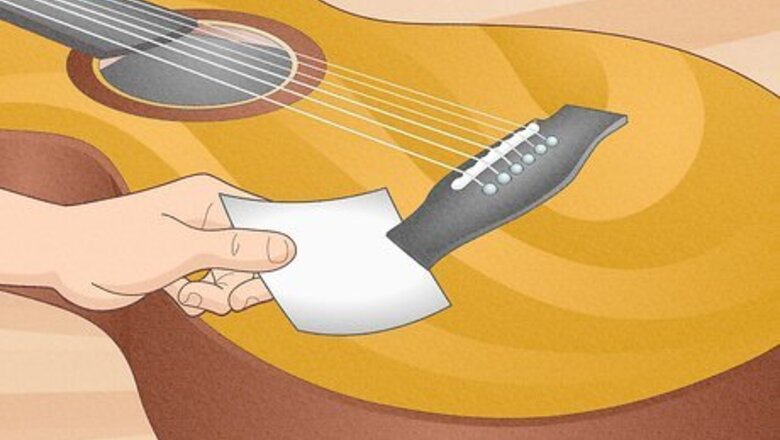
views
X
Research source
Removing the Old Glue
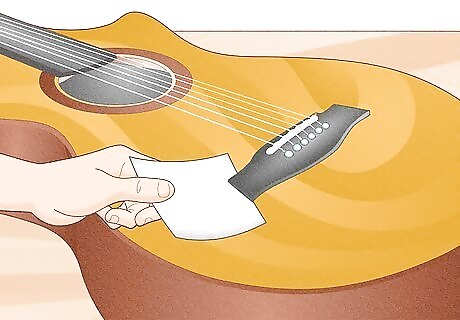
Check the looseness of the bridge with a thin sheet of paper. Try to slide a piece of paper under your bridge, between the bridge and the top of your guitar. If it slips through easily, this means the glue has loosened and your bridge needs to be fixed. Even if you can see a gap between the bottom of your bridge and the top of your guitar, you still need to check it. It might be that the guitar's lacquer doesn't reach to the edge of the bridge, which is attached to the bare wood, which can create the appearance of a gap. If the bridge itself is cracked or warped, it will need to be replaced. Don't attempt to re-glue it.
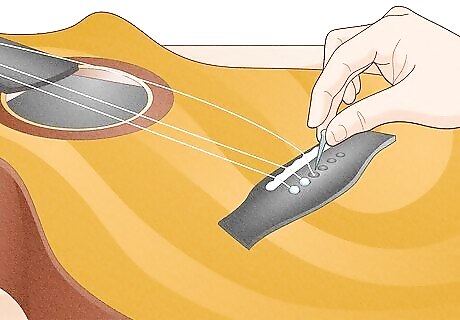
Take the strings off your guitar. Before you can work on the bridge, carefully remove all of the strings on your guitar, then pop out the string pins in the bridge. Set all of these to the side so you can replace them later. Inspect the bridge again with the strings off to make sure there aren't any cracks or other damage to the bridge that you didn't notice before.
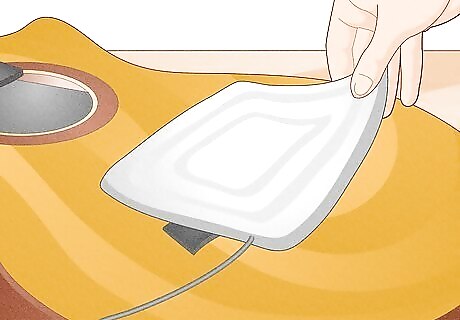
Use a heating pad to loosen up the existing glue. If the bridge is just starting to lift, the heat will melt the remaining glue so you can remove the bridge without damaging it. Check the glue every couple of minutes by wiggling the bridge a bit. Remove the heat when it feels loose. Luthiers use a specially designed heat blanket for this purpose. A dry heating pad designed to soothe sore muscles will work for this. Don't leave the heat on your guitar any longer than necessary to avoid damage to the finish or the wood.
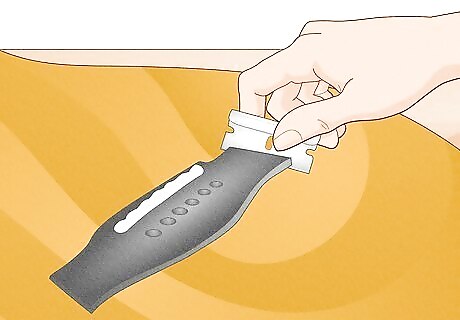
Pry the bridge off gently with a razor blade. Work your blade carefully around all the edges of the bridge. Don't force it! You may need to go around more than once before the bridge comes off freely. Then, set the bridge off to the side. If you have an acoustic-electric guitar, be careful not to remove any of the wiring when you remove the bridge. Simply leave that attached and let the bridge dangle to the side.
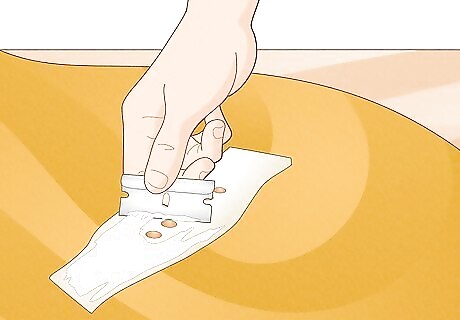
Scrape any remaining glue off the top of the guitar. Any dried glue still left on the top of your guitar or the bottom of the bridge will create an uneven surface to glue your bridge back on. Use a chisel or razor blade to gently remove it. You want to glue your bridge directly to the guitar. If you attempt to glue it to old dried glue, it won't seal and you'll have to re-glue it all over again. Sandpaper also works well to clean dried glue from the body of the guitar and the underside of the bridge. Just be careful not to sand too hard.

Score the underside of the bridge with a razor blade. Cut some horizontal and vertical lines across the bottom of the bridge so the glue will get more traction for a tighter bond. Be careful not to gouge too deeply as you could crack the bridge. If your bridge was attached directly to the lacquer of the guitar rather than the raw wood, as is the case with some more inexpensive guitars, score the lacquer as well. Take care not to cut into the actual wood of the guitar when you do this.
Re-gluing the Bridge
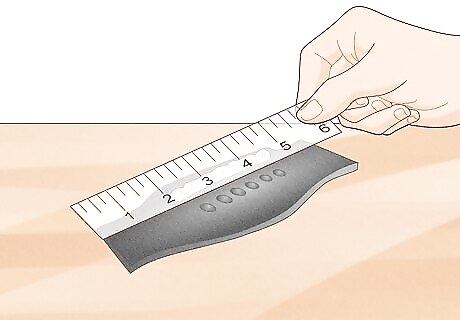
Use a ruler to measure the midpoint of your bridge. Marking the midpoint of your bridge helps you place it back on the guitar in the exact same spot it was before. Mark the centerline of the bridge with a pencil both on the top of the bridge and on the guitar where the bridge sits. Then, you can simply match up those 2 lines to put your bridge back in place.
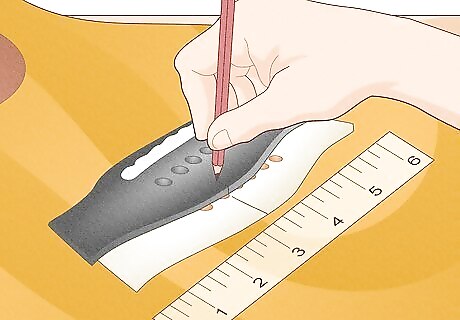
Measure and mark your bridge to ensure you replace it correctly. Use a ruler to mark the middle of your bridge and line it up with the middle of the spot where your bridge was located on the top of your guitar. This will help you line up your bridge so you can re-glue it in the exact same spot. You can also place wooden dowels in the bridge pin holes and set your bridge down on top of those. After you've placed your bridge, you can just pop the dowels out. They'll help you line up the bridge over the holes. If you don't put your bridge back in exactly the same spot, it will throw your string tension off and ruin your guitar's intonation.
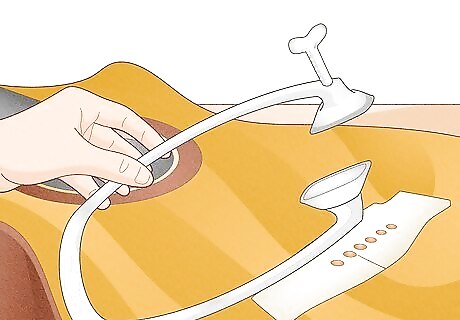
Choose a C-clamp large enough to clamp the bridge through the soundhole. The clamp ensures that your bridge is glued tightly to your guitar. Get a deep C-clamp capable of fitting through the soundhole of your guitar and clamping the bridge down tightly. Check the fit before you put glue on the bridge to make sure it'll work. Depending on the size and design of your clamp, you may want to use a caul, which is simply a piece of wood that you lay between the braces of the clamp and the bridge itself. The caul distributes the pressure of the clamp more evenly so you can apply enough pressure to set the glue without damaging the bridge. You can also use 3 clamps, using 1 for each end of the bridge and 1 for the middle. If you use 3 clamps, you won't need to apply as much pressure on each clamp.
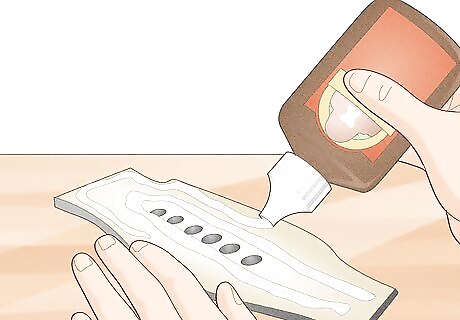
Apply wood glue to the bottom of the bridge. Squeeze the wood glue around the entire edge of the bridge and inside, keeping away from the bridge pin holes. Don't worry about using too much glue — you can wipe away any excess after you clamp down the bridge. You could also apply the glue to the top of your guitar rather than to your bridge. There's no need to glue both, however. It won't make the bond any stronger — you'll just end up with a lot of extra glue.
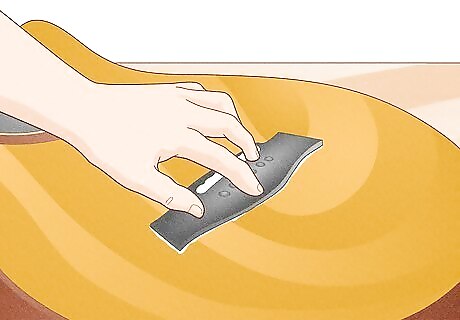
Press your bridge into place on the top of your guitar. Use the marks or dowels you placed in the bridge pin holes to line up your bridge in the exact spot it was before. Check the outer edges to make sure it's lined up properly while the glue is still wet. Then press down firmly. When you press down, you'll likely see excess glue seeping out from the edges of the bridge. Wait until you've clamped down the bridge to wipe it away. Otherwise, you risk wiping away too much glue and your bridge won't bond to your guitar.

Clamp the bridge down onto the guitar. If you're only using 1 clamp, place your caul over top of the bridge, then place the bottom of the clamp through the soundhole into the body of your guitar, under the bridge. Clamp it down just enough to hold the seal tight, but not enough to squeeze out all of the glue. If you're using 3 clamps, get the ends in place first and set the middle clamp last. If you don't want the clamps to damage the finish on the bridge, lay a piece of felt or cloth between the bridge and the clamp.
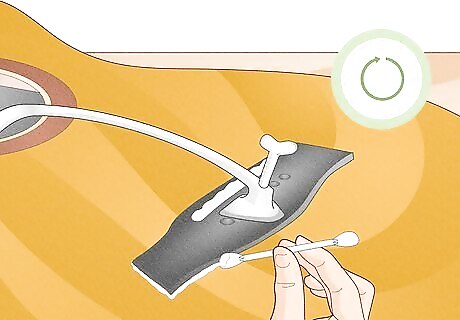
Wipe the excess glue and leave the bridge clamped at least overnight. Use a cotton swab or rag to clean off any excess glue that seeped out from under the edge of the bridge. Then, leave your guitar laying flat with the clamps in place so the glue can dry. It will take at least 12 hours for the glue to dry. However, if you take off the clamps and the glue hasn't dried, you effectively have to start all over. To be safe, you might want to leave your guitar for a couple of days before you attempt to restring it. If you try to restring your guitar before the glue has completely dried, the tension from the strings (200 pounds worth!) will pop the bridge off again.


















Comments
0 comment